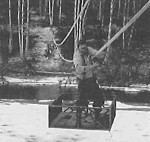Access to the Caribou-Poker Creeks Research Watershed (CPCRW) became easier this summer with the construction of a new bridge across the Chatanika River. Since the establishment of CPCRW, one of the two research sites of the Bonanza Creek LTER program (BNZ) in the Alaska boreal forest, getting researchers into the site had been a major problem.
In summer, vehicle access was limited to fording the Chatanika River or by a long and arduous four-wheeler trail over Haystack Mountain.
In periods of high water and during break-up and freeze-up, individual researchers' only access across the river was via a 50-meter-long cable strung between a tree on each bank. Researchers rode in a basket, hung beneath the cable on a pulley, and pulled themselves to the other side.
In Winter, access was by snow machine across the frozen river.
All of that changed in July 1995 when, through the efforts of the U.S. Forest Service’s Pacific Northwest station and the U.S. Army Cold Regions Research Laboratory (CRREL), a bridge was constructed across the Chatanika River. The successful completion of the bridge project is the culmination of 20 years of effort by Dr. Charles Slaughter, for many years the Forest Service scientist in charge of the CPCRW. Dr. Slaughter searched diligently for a “surplus” bridge that could span the 50-meter-wide Chatanika River. Following the Gulf War, a Bailey Bridge used in military operations was located in Europe and shipped by the U.S. Army to Fairbanks, where it was stored at the University of Alaska’s Poker Flats Rocket Range adjacent to the watershed. Dr. Slaughter then managed to obtain the necessary $60,000 from PNW’s construction fund, primarily for construction of the bridge abutments and access road.
The U.S. Army Cold Regions Research and Engineering Laboratory agreed to take on the responsibility of actually constructing the bridge as part of a realistic training session simulating conditions of an oil field in Siberia. The simulation included a group of”eco-terrorists” who tried to prevent the bridge’s construction. For about three weeks in July, as the bridge was being constructed, researchers traveling into CPCRW were scrutinized carefully by the Army units guarding the construction site. The completed bridge will remain the property and responsibility of CRREL, an agency with many long-term research projects in the research watershed.
Ironically, the completion and dedication of the bridge occurred during the same week that PNW administrators were in Fairbanks announcing that the Institute of Northern Forestry would be closed due to recent Forest Service budget cuts. Fortunately, the bridge was completed before this closure and is now available to LTER and other researchers, making access to their research sites much easier on a year-round basis.


 Enlarge this image
Enlarge this image